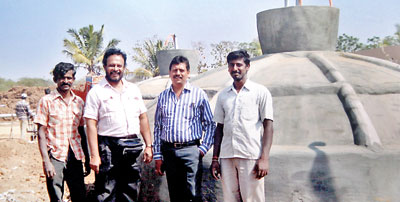Lankan makes waves in waste-water treatment in India
View(s):Eco-engineer Athula Jayamanne’s invention in the forefront to solve the problem of desiccated coconut mills polluting the environment in the state of Karnataka.
Kumudini Hettiarachchi reports
It is usually north to south that not only expertise but also technology flows – from big neighbour India to tiny Sri Lanka. The trend is now reversed. For, in his own small way 54-year-old eco-engineer Athula Jayamanne has made his mark in India by taking waste-water treatment which he has turned into a fine art after a decade of research in Sri Lanka along with bio-gas technology across the Palk Straits.

Sri Lankan technician Shantha Kumar who supervised the construction of the waste-water treatment plant, eco-engineer Athula Jayamanne, DC mill owner Arun Kumar and Indian supervisor Yatish at the site
He believes that it is the first time advanced bio-gas technology has been despatched from Sri Lanka to India. The transfer began as there was trouble in the large desiccated coconut mills in India. Although in many fields this powerful country was so advanced as to be able to launch rockets into space and had thousands of experts on waste-water treatment, there was a “block” in this line, says Mr. Jayamanne.
The country’s desiccated coconut mills were polluting the environment and in Karnataka there was desperation. A solution was needed badly, but there simply seemed to be no answer from within this mighty nation. It was then that the Pollution Control Board of Bangalore searched the web and picked up many names including that of Mr. Jayamanne, the General Manager and Chief Consultant Engineer of Eco Engineers based in Negombo, Sri Lanka.
His waste-water treatment plants are in use in industries, garment factories, hotels, restaurants, offices, banks, bakeries, breweries and even the Chettikulam Hospital and the Menik Farm internally displaced people’s camp, in fact in about 100 places. There was a double boon. In went large volumes of waste water and with no consumption of energy which is usually very costly and no production of sludge, out came energy in the form of biogas and clean water. “During the whole process, there is zero consumption of energy,” reiterates Mr. Jayamanne, explaining that it is a tried and tested method at the palm-oil mill at Nakiyadeniya, “a very big biogas producer”.
He has also won many awards for his technology, the most recent being the ‘Most Commercially Successful Inventor’ in April 2012 awarded by the Science and Technology Ministry and the ‘Sahasak Nimavum National Award’ in December 2012 by the Sri Lanka Inventors’ Commission.
In the wake of the web search and impressed by the numerous awards, came an invitation. It was for Mr. Jayamanne to attend several seminars for Pollution Control Board staff, industrialists and local waste water experts from New Delhi and Mumbai. Armed with detailed presentations, he took up the invite and the rest followed naturally, with two desiccated mill owners making a trip to Sri Lanka in 2012 to see first-hand the success of the process.
“Realizing this was the answer to their troubles, they then took me to their mills to gather initial data to design a custom-made system. We also exported special items to them from here,” says Mr. Jayamanne. Construction followed in December 2012 and by mid-January this year, the job was done.
The system is now working satisfactorily, he smiles, detailing the nitty-gritty of the work. These massive DC mills usually put out 40 cubic metres of waste water per day, with the pollution level being 40 times greater than from a normal septic tank carrying sewerage. Now this huge volume is being treated according to the standards set by the Pollution Control Board (similar to Sri Lanka’s Central Environmental Authority) which the DC mills had found difficult to meet earlier.
With 50% of the project costs being funded by the Indian government as an outright grant, Mr. Jayamanne’s hopes are high that with the system functioning well, little Sri Lanka’s waste-water treatment technology would be replicated across India.
The irony is obvious. In 1994, while working at the National Engineering Research and Development (NERD) Centre, Mr. Jayamanne had received a World Bank scholarship to study biogas technology at the Rajasthan University in India where he gained a rudimentary knowledge, which he followed up with extensive research.
Now the time has come for Mr. Jayamanne to transfer his enhanced knowledge both on waste water treatment and biogas back to the Indians, while there have also been queries from the Maldives and Malaysia.
Athula’s UAFF shows the way
It is not just a dwarf but a giant that is using eco-engineer Athula Jayamanne’s expertise and knowledge. The two biggest DC mills using the waste-water treatment plant and biogas technology in India are Mahavir Coconut Manufacturing Pvt Ltd., 90km from Tumkur in Bangalore.
Processing 150,000 nuts per day, one of these DC mills, in addition to producing a massive quantity of waste water, was also facing water issues as the water table is 900ft below ground level. The coconut plantations have had to use water from tube wells. Now the treated waste water irrigates Mahavir’s coconut lands while part of the mill’s thermal requirements is being met by the biogas, Mr. Jayamanne says.
This eco-engineer uses the ‘Up-flow Anaerobic Floating Filtre’ (UAFF) invented and patented by him which fits in well with the world’s green trend.
It doesn’t consume any electricity but captures biogas as an energy source, he says, pointing out the other advantages as not needing periodical maintenance unlike conventional waste-water treatment systems as this does not have an aeration machine; not needing lime application after six months of operation in case of acidic waste water; the production of alternative fuel in the form of biogas; and the elimination of micro-organisms such as viruses and bacteria by the anaerobic digestion of waste-water which controls water- borne disease.
Follow @timesonlinelk
comments powered by Disqus


















